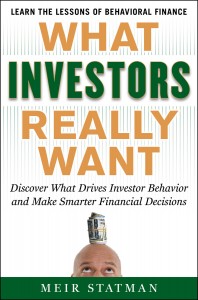“Teaching clients the science of human behavior” is how financial advisors can help clients to overcome the fears that prompt bad  decisions, writes Meir Statman in “Client fears and financial advisor services,” his guest post on my blog.
decisions, writes Meir Statman in “Client fears and financial advisor services,” his guest post on my blog.
That may be easier said than done. As financial technology blogger Bill Winterberg said, “For a minority of clients, I think teaching the science of behavior may work in changing habits, but for the overwhelming majority, primitive survival instincts are seemingly impossible to counteract.”
I asked some experts–Rick Kahler, Justin Reckers, and Kathleen Burns Kingsbury–to contribute brief reactions to this controversy. Here are their responses.
Kahler: Partnering with a financial psychologist helps
Based on my experience with financial psychology, it is doubtful that all it would take for most investors to change their financial behaviors when feeling fear is more information about how the brain works. While more information will be enough for some investors to change their destructive, it really won’t help the majority.
Changing harmful financial decisions is similar to changing the behavior of any addiction. More information on alcoholism won’t be enough to change the destructive behavior of most alcoholics. Knowing you have a drinking problem is certainly the first step, but “knowing” isn’t “doing.” The same principals go for over-eaters or over-spenders. More information is rarely enough.
It takes a deeper “re-wiring” of the brain to create new neuropathways to change the manner in which we respond to difficult emotions, like fear. There are many tools available to help people do this, the most well-known being various forms of psychotherapy and group psychotherapy.
This is an example where a financial planner who partners with a financial psychologist can have such a positive impact on hurtful financial behaviors.
Rick Kahler is president of Kahler Financial Group in Rapid City, S.D. He writes the Financial Awakenings blog and is a pioneer in the evolution of integrating financial psychology with traditional financial planning profession.
Reckers: Professionals who work directly with clients will make the practical breakthroughs
I think an understanding of the science of human behavior is valuable in any setting. I do not believe “teaching clients the science of human behavior” will do much to counteract economically “irrational” behavior in financial decision-making. This is especially true when the decisions are made in the midst of emotions like fear or greed. Emotional biases are difficult if not impossible to dispel. They often require an advisor to adapt their own behavior to help work with the client’s emotional decision-making rather than try to change them. Advisors must remember that the fear exhibited by their clients is a reflection of the individual’s financial reality. I agree with Statman when he says “the fear of clients is normal.” I also believe one of the most important functions of an investment advisor is to help clients make fully informed decisions whether beset by fear or not. So I do not think the term characterizes what we should be concerned about. We will return to bull market territory and the emotions with which advisors contend will shift from fear to greed.
The real revolutionary contribution to Behavioral Finance will be a framework for advisors to apply concepts while working with clients. This framework will be developed by professionals who actually work with clients. The contributions of Statman, the Libertarian Paternalism of Thaler, the Heuristics of Kahneman & Tversky, the experiments and research of Ariely and so on, are amazing, important and exciting. But they mostly miss the next step: application to real individual lives. (Note: I have not read Statman’s book in its entirety. I will.) Otherwise we are left to contemplate whether “teaching clients the science of human behavior” will make any difference in how they actually behave at the moment of truth. I believe calculated interactions, interventions and nudges are necessary to truly have a positive effect on the financial decision-making of our clients.
Justin A. Reckers CFP, CDFA, AIF, is director of financial planning at Pacific Wealth Management. He writes with clinical psychologist Robert Simon, Ph.D., in the Practice Builder section of www.MorningstarAdvisor.com and on their blog www.BehavioralFinances.wordpress.com
Kingsbury: Rationality vs. “Fight or flight” response
Meir Statman’s prescription for financial advisors is right on the money. Clients do react, and often overreact, when emotions are involved in financial decision-making. Numerous behavioral finance experiments, some mentioned in Statman’s blog post, show how rational thought is overruled by a desire to minimize the pain of a financial loss.
Neuroscience tells us that the brain actually processes financial losses differently than gains. This results in clients experiencing the anticipation or actual pain of loss three times more than the joy of a financial windfall. Scans of the brain tell us that the limbic system, normally accessed during sudden or traumatic events, is used when facing a potential loss. In contrast, the frontal lobes, the part of your brain where rational thought and executive functions, processes financial gains. By knowing this science and educating clients about it, financial advisor can help counteract the fight-or-flight response when fear is part of the equation by offering rational, longer-term solutions.
Understanding behavioral finance and the human side of financial advising is paramount to offering client-centric services. Not only will this knowledge help the advisor in guiding his client, it will empower the client to understand his own psychology and use the advisor more effectively. Like it or not, all of us are flawed, emotional human beings.
Kathleen Burns Kingsbury is founder and CEO of KBK Wealth Connection, a company passionate about helping financial services professionals and their clients master their money mindset through wealth psychology. She is the author of a new audio program called Creating Wealth from the Inside Out.
 question recently arrived in my email in-box.
question recently arrived in my email in-box.. Bolland’s book is probably worth checking out.)
.









